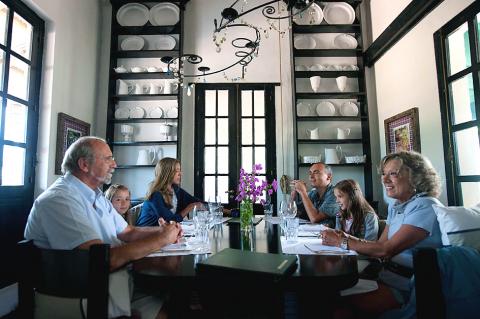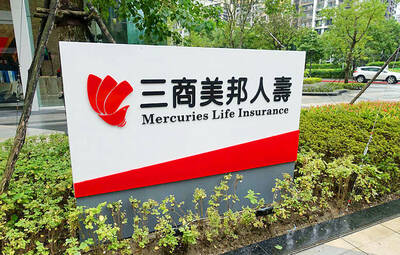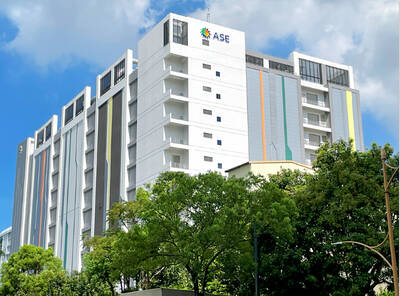It is a dusty village of 200 nestled in Uruguay’s back country, with no obvious architectural attraction, which most tourists would drive through without a second thought.
However, in recent years, the town of Pueblo Garzon, 70km from the bustling beach resort of Punta del Este, has become a draw for the international jet set looking for peace and quiet, along with authenticity and a taste of some unique gastronomy.
The transformation of the modest village began eight years ago when renowned Argentine chef Francis Mallmann opened a hotel and restaurant on a site where a grocery store used to be.

Photo: AFP
That attracted some well-heeled visitors and started a trend in the village of dirt roads and lush tropical vegetation.
Today, the streets are lined with luxury cars, high-end restaurants and boutiques and plenty of visitors from around the globe willing to spend US$170 for lunch or US$780 for a hotel room with rustic charm during the high season of December to February.
In the town, which had been a stop for travelers in the mountains and the site of wheat mill, visitors can dine on smashed gigot of lamb, magret of duck with malbec juice and varietal wines from the region.
They can stay overnight in rooms with wood-burning chimneys and other refinements.
“The idea is to allow customers to relax, to take horseback or bicycle rides, to take advantage of nature, silence and good food, and to get away from the city, the beach and the crowds,” said Victoria Ubertone, hotel manager at the Garzon hotel and restaurant.
“The calm is impressive. It is a back country village like a lot of others, but very chic,” said Monica Testoni, an Argentine who was vacationing in Punta del Este and made a trip for lunch to Garzon.
Across the town square, another famed Argentine chef, Esteban Aguirre, recently opened his restaurant and cultural center called D’Cepa, encouraged by the success of Mallmann and others.
Along with Lucifer, the other upscale restaurant in town, “we are trying to round out our offerings for tourists,” Aguirre said.
The influx of wealthy tourists along with the installation of a food processing plant in 2000 is a godsend for local residents, who had been hoping for a restoration of a rail link that was abandoned when a wheat mill shut down.
“There is a change in the outlook for people,” Garzon Mayor Fernando Suarez said. “The village is finding a new direction.”
With the town’s transformation, more people are seeking to build homes, in some cases hiring local residents for upkeep. Some of those investing, according to locals, include British art dealer Martin Summers and a top executive of the New York Times.
This has caused a jump in land prices, so a lot of 400m2, which used to sell for US$1,000 now can go for upwards of US$30,000.
Suarez said this is not a problem because “those who come here respect the essence of the village.”
However, others like Veronica Deliotti, a restaurant worker, wonders if the small town atmosphere is disappearing.
“Our children’s future is changing,” she said. “Sometimes I’m afraid. We don’t want to lose this tranquility.”

Mercuries Life Insurance Co (三商美邦人壽) shares surged to a seven-month high this week after local media reported that E.Sun Financial Holding Co (玉山金控) had outbid CTBC Financial Holding Co (中信金控) in the financially strained insurer’s ongoing sale process. Shares of the mid-sized life insurer climbed 5.8 percent this week to NT$6.72, extending a nearly 18 percent rally over the past month, as investors bet on the likelihood of an impending takeover. The final round of bidding closed on Thursday, marking a critical step in the 32-year-old insurer’s search for a buyer after years of struggling to meet capital adequacy requirements. Local media reports

AI BOOST: Although Taiwan’s reliance on Chinese rare earth elements is limited, it could face indirect impacts from supply issues and price volatility, an economist said DBS Bank Ltd (星展銀行) has sharply raised its forecast for Taiwan’s economic growth this year to 5.6 percent, citing stronger-than-expected exports and investment linked to artificial intelligence (AI), as it said that the current momentum could peak soon. The acceleration of the global AI race has fueled a surge in Taiwan’s AI-related capital spending and exports of information and communications technology (ICT) products, which have been key drivers of growth this year. “We have revised our GDP forecast for Taiwan upward to 5.6 percent from 4 percent, an upgrade that mainly reflects stronger-than-expected AI-related exports and investment in the third

TECHNOLOGICAL RIVALRY: The artificial intelligence chip competition among multiple players would likely intensify over the next two years, a Quanta official said Quanta Computer Inc (廣達), which makes servers and laptops on a contract basis, yesterday said its shipments of artificial intelligence (AI) servers powered by Nvidia Corp’s GB300 chips have increased steadily since last month, should surpass those of the GB200 models this quarter. The production of GB300 servers has gone much more smoothly than that of the GB200, with shipments projected to increase sharply next month, Quanta executive vice president Mike Yang (楊麒令) said on the sidelines of a technology forum in Taipei. While orders for GB200 servers gradually decrease, the production transition between the two server models has been

ASE Technology Holding Co (日月光投控), the world’s largest integrated circuit (IC) packaging and testing supplier, yesterday announced a strategic collaboration with Analog Devices Inc (ADI), coupled with the signing of a binding memorandum of understanding. Under the agreement, ASE intends to purchase 100 percent shares of Analog Devices Sdn Bhd and acquire its manufacturing facility in Penang, Malaysia, a press release showed. The ADI Penang facility is located in the prime industrial hub of Bayan Lepas, with an area of over 680,000 square feet, it said. In addition, the two sides intend to enter into a long-term supply agreement for ASE to